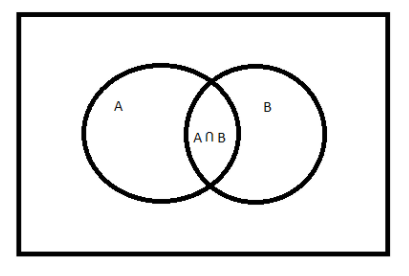
If X and Y are two sets such that $X \cup Y$ has 18 elements, X has 8 elements, and Y has 15 elements, how many elements does $X \cap Y$ have?
Answer
573.3k+ views
Hint:
We have to sets X and Y. The number of elements in each set is given and the number of elements in the union of both sets is also given. Then we can find the number of elements in the intersection of both sets using the equation $n\left( {X \cap Y} \right) = n\left( X \right) + n\left( Y \right) - n\left( {X \cup Y} \right)$.
Complete step by step solution:
We are given to sets X and Y.
The number of elements of X is given as 8
$ \Rightarrow n\left( X \right) = 8$
The number of elements of Y is given as 15
$ \Rightarrow n\left( Y \right) = 15$
And the number of elements of $X \cup Y$ is 18
$ \Rightarrow n\left( {X \cup Y} \right) = 18$
We need to find the number of elements in the set $X \cap Y$
We know that, $n\left( {X \cap Y} \right) = n\left( X \right) + n\left( Y \right) - n\left( {X \cup Y} \right)$
Substituting the values in the equation, we get,
$ \Rightarrow n\left( {X \cap Y} \right) = 8 + 15 - 18$
On simplification we get,
$ \Rightarrow n\left( {X \cap Y} \right) = 5$
Therefore, the number of elements in $X \cap Y$ is 5.
Note:
The concept used here is set theory. Union of two sets gives a set of all elements that are at least in one of the two sets. If A and B are 2 sets, then its union is written as $A \cup B$ and it contains all the elements in A along with all the elements in B. Intersection of two sets gives the set of all elements that are in both the sets. If A and B are 2 sets, then its intersection is written as $A \cup B$ and it contains all the elements that are both in A and B.

Venn diagram is used to represent sets. It helps us to understand sets, its union and intersection and other set operations. In a Venn diagram, each set is separated by a circle or a curve. The elements inside each curve belong to that particular set. If the curves are overlapping means that the elements are contained in all the overlapping sets. The Venn diagram is enclosed in a rectangle which represents the universal set.
We have to sets X and Y. The number of elements in each set is given and the number of elements in the union of both sets is also given. Then we can find the number of elements in the intersection of both sets using the equation $n\left( {X \cap Y} \right) = n\left( X \right) + n\left( Y \right) - n\left( {X \cup Y} \right)$.
Complete step by step solution:
We are given to sets X and Y.
The number of elements of X is given as 8
$ \Rightarrow n\left( X \right) = 8$
The number of elements of Y is given as 15
$ \Rightarrow n\left( Y \right) = 15$
And the number of elements of $X \cup Y$ is 18
$ \Rightarrow n\left( {X \cup Y} \right) = 18$
We need to find the number of elements in the set $X \cap Y$
We know that, $n\left( {X \cap Y} \right) = n\left( X \right) + n\left( Y \right) - n\left( {X \cup Y} \right)$
Substituting the values in the equation, we get,
$ \Rightarrow n\left( {X \cap Y} \right) = 8 + 15 - 18$
On simplification we get,
$ \Rightarrow n\left( {X \cap Y} \right) = 5$
Therefore, the number of elements in $X \cap Y$ is 5.
Note:
The concept used here is set theory. Union of two sets gives a set of all elements that are at least in one of the two sets. If A and B are 2 sets, then its union is written as $A \cup B$ and it contains all the elements in A along with all the elements in B. Intersection of two sets gives the set of all elements that are in both the sets. If A and B are 2 sets, then its intersection is written as $A \cup B$ and it contains all the elements that are both in A and B.

Venn diagram is used to represent sets. It helps us to understand sets, its union and intersection and other set operations. In a Venn diagram, each set is separated by a circle or a curve. The elements inside each curve belong to that particular set. If the curves are overlapping means that the elements are contained in all the overlapping sets. The Venn diagram is enclosed in a rectangle which represents the universal set.
Recently Updated Pages
Why are manures considered better than fertilizers class 11 biology CBSE

Find the coordinates of the midpoint of the line segment class 11 maths CBSE

Distinguish between static friction limiting friction class 11 physics CBSE

The Chairman of the constituent Assembly was A Jawaharlal class 11 social science CBSE

The first National Commission on Labour NCL submitted class 11 social science CBSE

Number of all subshell of n + l 7 is A 4 B 5 C 6 D class 11 chemistry CBSE

Trending doubts
What is meant by exothermic and endothermic reactions class 11 chemistry CBSE

10 examples of friction in our daily life

One Metric ton is equal to kg A 10000 B 1000 C 100 class 11 physics CBSE

1 Quintal is equal to a 110 kg b 10 kg c 100kg d 1000 class 11 physics CBSE

Difference Between Prokaryotic Cells and Eukaryotic Cells

What are Quantum numbers Explain the quantum number class 11 chemistry CBSE




